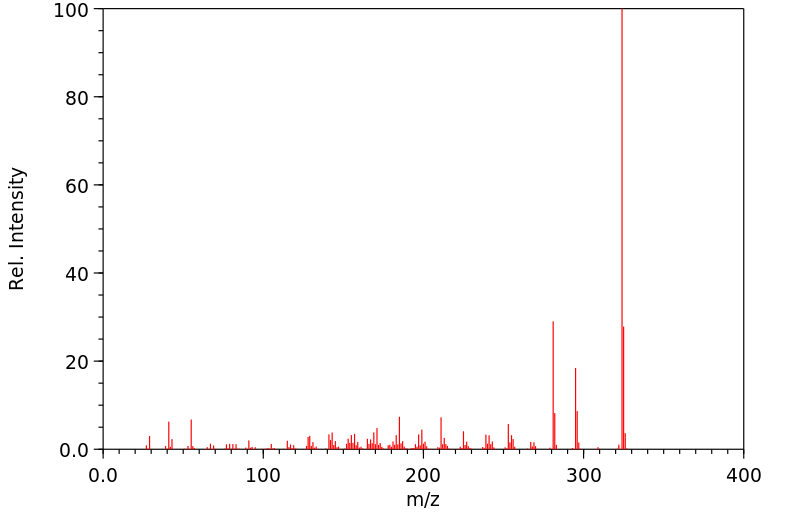1,2:3,4:5,6-tris(hexamethylene)benzene | 7099-19-6
中文名称
——
中文别名
——
英文名称
1,2:3,4:5,6-tris(hexamethylene)benzene
英文别名
tris-(hexamethylene)benzene;tris(hexamethylene)benzene;cyclooctyne trimer;Tris-1.2;3.4;5.6-cycloocteno-benzol;Tris-hexamethylen-benzol;Tris-cyclooctenobenzol;Tricyclooctenobenzene;tetracyclo[16.6.0.02,9.010,17]tetracosa-1,9,17-triene
CAS
7099-19-6
化学式
C24H36
mdl
——
分子量
324.55
InChiKey
VBIUHSAZNSYTGS-UHFFFAOYSA-N
BEILSTEIN
——
EINECS
——
-
物化性质
-
计算性质
-
ADMET
-
安全信息
-
SDS
-
制备方法与用途
-
上下游信息
-
文献信息
-
表征谱图
-
同类化合物
-
相关功能分类
-
相关结构分类
计算性质
-
辛醇/水分配系数(LogP):9.3
-
重原子数:24
-
可旋转键数:0
-
环数:4.0
-
sp3杂化的碳原子比例:0.75
-
拓扑面积:0
-
氢给体数:0
-
氢受体数:0
SDS
反应信息
-
作为产物:参考文献:名称:通过芳基羟胺与炔烃的环合反应直接合成3-芳基吲哚摘要:由10摩尔%的酞菁铁(II)[Fe(Pc)]催化的芳基羟胺与炔烃之间的反应,可产生中等至极高的产率的3-Arylindoles。末端和内部炔烃仅提供3-芳基取代的吲哚。给电子基团和吸电子基团在芳基羟胺上是可容忍的。使用这一一步分子间环化程序,可以合成一些生物活性吲哚以及几个新的吲哚。DOI:10.1016/j.tet.2009.03.004
文献信息
-
Superphanes with CpCo-Stabilized Cyclopentadienone Units. Synthesis and Properties作者:Rolf Roers、Frank Rominger、Bernhard Nuber、Rolf GleiterDOI:10.1021/om991000e日期:2000.4.1The cyclic alkynes 5-cyclononynone (23) and 5-cyclodecynone (24) were dimerized by heating with CpCo(CO)2 to form the tricyclic CpCo-stabilized cyclopentadienone derivatives 25 and 26, respectively. These diketones were transformed to the tricyclic diynes 30, 31, and 33, via the corresponding bis(selenadiazoles). Whereas the diynes 30 and 31 did not yield the desired bis(cyclopentadienono)phanes, we
-
Isolable Tris(alkyne) and Bis(alkyne) Complexes of Gold(I)作者:Animesh Das、Chandrakanta Dash、Muhammed Yousufuddin、Mehmet Ali Celik、Gernot Frenking、H. V. Rasika DiasDOI:10.1002/anie.201200080日期:2012.4.16Golden trefoils: Tris(alkyne)gold complex [(coct)3Au][SbF6] (see picture; 1‐SbF6) can be synthesized from cyclooctyne (coct) and AuSbF6 generated in situ. Treatment of AuCl with cyclooctyne led to the bis(alkyne)gold complex [Au(coct)2Cl] (2). DFT analysis indicates that the cyclooctyne ligands are net electron donors in 1 but overall electron acceptors in 2. AuSbF6 is shown to mediate [2+2+2] cycloaddition
-
Gmelin Handbuch der Anorganischen Chemie, Gmelin Handbook: Ni: Org.Verb.2, 2.4.1.3, page 325 - 332作者:DOI:——日期:——
-
Witting, G.; Fritze, P., Liebigs Annalen der Chemie, 1968, vol. 712, p. 79 - 83作者:Witting, G.、Fritze, P.DOI:——日期:——
-
Cycloalumination of cycloalkynes with triethylaluminum catalyzed by zirconium complexes作者:V. A. D’yakonov、L. F. Galimova、T. V. Tyumkina、U. M. DzhemilevDOI:10.1134/s1070428012010010日期:2012.1Cycloalumination of cycloalkynes with triethylaluminum in the presence of zirconium complexes was performed for the first time, and new bicyclic aluminacyclopentenes were obtained in 74-94% yield.
表征谱图
-
氢谱1HNMR
-
质谱MS
-
碳谱13CNMR
-
红外IR
-
拉曼Raman
-
峰位数据
-
峰位匹配
-
表征信息
同类化合物
(βS)-β-氨基-4-(4-羟基苯氧基)-3,5-二碘苯甲丙醇
(S,S)-邻甲苯基-DIPAMP
(S)-(-)-7'-〔4(S)-(苄基)恶唑-2-基]-7-二(3,5-二-叔丁基苯基)膦基-2,2',3,3'-四氢-1,1-螺二氢茚
(S)-(+)-5,5'',6,6'',7,7'',8,8''-八氢-3,3''-二叔丁基-1,1''-二-2-萘酚,双钾盐
(S)-盐酸沙丁胺醇
(S)-溴烯醇内酯
(S)-7,7-双[(4S)-(苯基)恶唑-2-基)]-2,2,3,3-四氢-1,1-螺双茚满
(S)-3-(叔丁基)-4-(2,6-二甲氧基苯基)-2,3-二氢苯并[d][1,3]氧磷杂环戊二烯
(S)-2-N-Fmoc-氨基甲基吡咯烷盐酸盐
(S)-2,2'-双[双(3,5-三氟甲基苯基)膦基]-4,4',6,6'-四甲氧基联苯
(S)-1-[3,5-双(三氟甲基)苯基]-3-[1-(二甲基氨基)-3-甲基丁烷-2-基]硫脲
(R)富马酸托特罗定
(R)-(-)-盐酸尼古地平
(R)-(-)-4,12-双(二苯基膦基)[2.2]对环芳烷(1,5环辛二烯)铑(I)四氟硼酸盐
(R)-(+)-7-双(3,5-二叔丁基苯基)膦基7''-[((6-甲基吡啶-2-基甲基)氨基]-2,2'',3,3''-四氢-1,1''-螺双茚满
(R)-(+)-7-双(3,5-二叔丁基苯基)膦基7''-[(4-叔丁基吡啶-2-基甲基)氨基]-2,2'',3,3''-四氢-1,1''-螺双茚满
(R)-(+)-7-双(3,5-二叔丁基苯基)膦基7''-[(3-甲基吡啶-2-基甲基)氨基]-2,2'',3,3''-四氢-1,1''-螺双茚满
(R)-(+)-4,7-双(3,5-二-叔丁基苯基)膦基-7“-[(吡啶-2-基甲基)氨基]-2,2”,3,3'-四氢1,1'-螺二茚满
(R)-7,7-双[(4S)-(苯基)恶唑-2-基)]-2,2,3,3-四氢-1,1-螺双茚满
(R)-3-(叔丁基)-4-(2,6-二苯氧基苯基)-2,3-二氢苯并[d][1,3]氧杂磷杂环戊烯
(R)-3-(叔丁基)-4-(2,6-二异丙氧基苯基)-2,3-二氢苯并[d][1,3]氧杂磷杂环戊烯
(R)-3,3''-双([[1,1''-联苯]-4-基)-[1,1''-联萘]-2,2''-二醇
(R)-2-[((二苯基膦基)甲基]吡咯烷
(R)-2,2'',3,3''-四氢-6,6''-二-9-菲基-1,1''-螺双[1H-茚]-7,7''-二醇
(R)-1-[3,5-双(三氟甲基)苯基]-3-[1-(二甲基氨基)-3-甲基丁烷-2-基]硫脲
(N-(4-甲氧基苯基)-N-甲基-3-(1-哌啶基)丙-2-烯酰胺)
(6,6)-苯基-C61己酸甲酯
(5-溴-2-羟基苯基)-4-氯苯甲酮
(5-溴-2-氯苯基)(4-羟基苯基)甲酮
(5-氧代-3-苯基-2,5-二氢-1,2,3,4-oxatriazol-3-鎓)
(4S,5R)-4-甲基-5-苯基-1,2,3-氧代噻唑烷-2,2-二氧化物-3-羧酸叔丁酯
(4S,5R)-3,3a,8,8a-四氢茚并[1,2-d]-1,2,3-氧杂噻唑-2,2-二氧化物-3-羧酸叔丁酯
(4S,4''S)-2,2''-亚环戊基双[4,5-二氢-4-(苯甲基)恶唑]
(4-溴苯基)-[2-氟-4-[6-[甲基(丙-2-烯基)氨基]己氧基]苯基]甲酮
(4-丁氧基苯甲基)三苯基溴化磷
(3aS,8aR)-2-(吡啶-2-基)-8,8a-二氢-3aH-茚并[1,2-d]恶唑
(3aS,3''aS,8aR,8''aR)-2,2''-环戊二烯双[3a,8a-二氢-8H-茚并[1,2-d]恶唑]
(3aR,8aR)-(-)-4,4,8,8-四(3,5-二甲基苯基)四氢-2,2-二甲基-6-苯基-1,3-二氧戊环[4,5-e]二恶唑磷
(3aR,6aS)-5-氧代六氢环戊基[c]吡咯-2(1H)-羧酸酯
(3S,3aR)-2-(3-氯-4-氰基苯基)-3-环戊基-3,3a,4,5-四氢-2H-苯并[g]吲唑-7-羧酸
(3R,3’’R,4S,4’’S,11bS,11’’bS)-(+)-4,4’’-二叔丁基-4,4’’,5,5’’-四氢-3,3’’-联-3H-二萘酚[2,1-c:1’’,2’’-e]膦(S)-BINAPINE
(3-三苯基甲氨基甲基)吡啶
(3-[(E)-1-氰基-2-乙氧基-2-hydroxyethenyl]-1-氧代-1H-茚-2-甲酰胺)
(2′′-甲基氨基-1,1′′-联苯-2-基)甲烷磺酰基铝(II)二聚体
(2Z)-3-[[(4-氯苯基)氨基]-2-氰基丙烯酸乙酯
(2S,4S)-Fmoc-4-三氟甲基吡咯烷-2-羧酸
(2S,3S,5S)-5-(叔丁氧基甲酰氨基)-2-(N-5-噻唑基-甲氧羰基)氨基-1,6-二苯基-3-羟基己烷
(2S,3R)-3-(叔丁基)-2-(二叔丁基膦基)-4-甲氧基-2,3-二氢苯并[d][1,3]氧杂磷杂戊环
(2S,2''S,3S,3''S)-3,3''-二叔丁基-4,4''-双(2,6-二甲氧基苯基)-2,2'',3,3''-四氢-2,2''-联苯并[d][1,3]氧杂磷杂戊环
(2S,2''S,3S,3''S)-3,3''-二叔丁基-4,4''-二甲氧基-2,2'',3,3''-四氢-2,2''-联苯并[d][1,3]氧杂磷杂戊环







